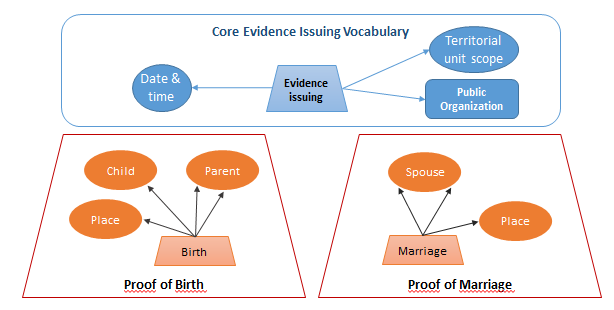Canonical Evidence
Canonical Evidence is the canonical form of a domestic evidence according to a common data structure and format. DE4A has defined a canonical form for each of the evidence types required by the procedures involved in the cross-border evidence exchange. Since canonical evidence is not lawfully issued evidence, issuing authorities should provide both domestic and canonical evidence and they are responsible for the accuracy of the matching between canonical and domestic evidences. In this way, canonical evidence is aimed at the automated processing of cross-border and domestic evidence for legal audits at a regular basis or at the request of interested parties. This approach follows the logic behind the multilingual standard forms set by the Regulation 2016/1191 on Public documents.
The canonical form for each evidence type that has been identified is called canonical evidence type and these types are essential for the semantic interoperability of cross-border evidence, since they provide agreements on concepts, meanings, languages and ways to represent the information.
| ID | Name | Description | DE4A Pilot: Use Cases |
|---|---|---|---|
| CompanyRegistration | Proof of Company Registration | The evidence exchanged across-border in the event of starting a business in another EU Member State. | DBA UC1 |
| HigherEducationDiploma | Proof of Completion of Higher Education | Represents all pertinent aspects of CE for applying to public higher education | SA UC1 |
| SecondaryEducationDiploma | Proof of completion of Secondary Education | Represents all pertinent aspects of CE for applying to public secondary education | SA UC1 |
| DisabilityEvidence | Proof of DisabilityEvidenceType | This evidence serve the purpose of proving a proof that the student suffer from a disability for deciding on if a student is entitled for study grant | SA UC2 |
| LargeFamilyEvidence | Proof of a Large Family | Evidence for proof of that the student is a member of a large family | SA UC2 |
| DomicileRegistrationEvidence | Proof of Domicile Registration | Evidence for registering a domicile abroad. | MA UC1 |
| DomicileDeregistrationEvidence | Proof of Domicile Deregistration | Evidence for removing the registration when the person is registered in another country | MA UC1 |
| BirthEvidence | Proof of Birth | Official document or data proving the Birth of a Child. | MA UC2 |
| MarriageEvidence | Proof of Marriage | Official document or data proving the Marriage of two Persons. | MA UC2 |
| PensionMeansOfLivingEvidence | Proof of Pension means of Living | The evidence holds information on the pension benefits. | MA UC3 |
| UnemploymentMeansOfLivingEvidence | Proof of pension by unemployment | The evidence holds information on unemployment benefits. | MA UC3 |
| WorkingLifeMeansOfLivingEvidence | Proof of working life as a pension | The evidence holds information on the working life benefits. | MA UC3 |
Canonical evidence types are implemented according to common data models that are defined from domain-specific ontologies, which reuse existing standard agnostic and specific vocabularies, code lists and data models. Canonical evidence types and common data models are defined according to agreements reached by involved authorities; in the case of the DE4A project, the agreements have been reached by the participants in the DE4A pilot use cases.
The terms of each canonical evidence type are described in detail in the Multilingual Ontology Repository in order to allow competent authorities to perform the necessary tasks for mapping their domestic evidence with the corresponding canonical form with an accuracy matching between them.
Methodology for Modelling Canonical Evidences
The canonical evidences development process is consisted of the three stages illustrated in Figure below. The process is following an incremental development methodology under agile principles. Hence, in this setting, the WP leader plays the role of the product owner, working in a technical working group with the other two technical works packages, WP4 “Cross-border Pilots for Citizens and Business and Evaluation” and WP5 “Common Component Design & Development”, following the same development cycles, as described in the DE4A grant agreement. The canonical evidences are co-created together with the users (the piloting member states), allowing the data models created to best fit the requirements of each member state piloting the evidence exchange. The key stages of the process include elicitation, development and evaluation of the data models.
Accordingly, the preliminary data models are designed based on the existing resources in Stage 1 of the process. The primary models are tested with the piloting member state for model accuracy with respect to the attributes, cardinalities and the affordances of existing vocabularies and code lists. This was an iterative process followed by close dialogue with the respective pilot teams. The XML schemas for the models are developed in Stage 2 in close collaboration with the pilot partners and finally the schemas are validated with the support of WP5 “Common Component Design & Development” during the integration into the technical system.


